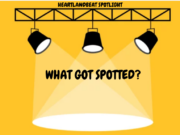Coming Events
Nebraska Weather and Planting Season
I hope you had a Safe weekend and didn’t have any major damage as a result of the stormy weather. They did a great job of warning us about the potential for storms. I checked my rain gauge and I had 1.75†over the weekend. You can almost see how the area lawns have greened up as a result of the rain. Over all in our area, I believe that much of the moisture soaked in and not a whole lot ran off.
I know that now that we’ve received a little moisture both producers and gardeners will want to get in and start getting things planted! I checked the CropWatch site (http://cropwatch.unl.edu) Monday morning and soil temperatures at the 4†depth averaged 54.7° F this past week compared to our normal average of 44.5° F. I’ve seen a few producers doing some planting, but the vast majority of the acres in our area have not been planted. Hopefully we’ll have some nice weather! I know that a lot of acres can be planted in a relatively short period of time!
We are still looking for producers that want to be involved with our on-farm research! If you’d be interested in helping us collect some seeding rate, check out this website: http://ardc.unl.edu/onfarmresearch.shtml and contact Keith Glewen, UNL Extension Educator, 1071 County Road G, Ithaca, Nebraska 68033, at 402-624-8030 or by email at kglewen1@unl.edu or me at 402-326-5508 or email at gzoubek1@unl.edu. Keith and I along with many Nebraska growers will be excited about you helping collect some of data on corn planting rates.
Little Diggers Planting
We had a great day Saturday out at Faller Landscape & Nursery! We had two groups of “Little Diggers†and what seemed like over 100 excited young people, moms and dads and grandparents out planting and learning about growing vegetables. In a two hour span we planted potatoes, cole crops, onions, leeks, peas as well as radishes and carrots! It was great to see the excitement and enthusiasm the young people had! We be doing a lot more planting and harvesting down the road, for more information about this great program or to register go to: http://www.fallerlandscape.com/ or call them at 402-362-2714.
4-H Veggies Plants, Seeds & Flowers Â
I mentioned it last week, but I want to remind area 4-H leaders and parents that most of this year’s Specials Howard and Dorothy May plants and seeds are now in and can be picked up at the Extension Office. 4-H members in the gardening projects are encouraged to stop the Extension Office and pickup the onion and leek plants as well as the cucumber and sunflower seeds. It’s time to get many of these crops into the garden so that we’ll have some great veggie/flower exhibits at this year’s fair!
Lawn Care Information
Last Thursday I had an opportunity to go down to Clay Center and share some gardening tips with homeowners in that area! We had a great time sharing some tips about what to and what not to do regarding lawn care. We went over reading the label and what each of the numbers on the bag of fertilizer represent! The first number is nitrogen, the second number is phosphorus and the third number is potassium. I want to thank the folks from Ace Hardware for allowing me to borrow a few bags of fertilizer so we could do some math and estimate the amount of slow release nitrogen the various products have. What we typically want is as much slow release nitrogen as possible so that we don’t get big uptakes of nitrogen all at once, but rather over a period of time.
We shared tips about how to calibrate your spreaders so that you don’t have dark and light strips of grass after you’ve fertilized your lawn. You should read the fertilizer label to determine the proper setting! What I try and do is apply at ½ the rate and then do it in two directions. It does a couple of things, I get a few extra steps in for my health, but I also get more uniform coverage! I often measure out an area (say 1,000 square feet) and then put that amount of fertilizer in the spread and spread it. If I’ve applied too much I cut the rate back and if I did not apply enough and increase the rate until I get it set just right!
After you’ve applied your fertilizer or mowed your lawn with a mulching blade it’s a good idea to blow the fertilizer or lawn clips back on to your turf rather than allow them to be washed away in to the streams and ponds. I use my lawn clipping in the garden or recycle them as much as possible. By mulching, you’ll be able to reduce the amount of nitrogen that you’ll need to apply. It’s important to maintain a sharp mower blade, it’s easier on your plants.
I also shared some tips about evaluating your lawn sprinklers to see if they’re applying the needed amounts of moisture in all locations of your lawns. What you can do is use red solo cups (or any color you want) and place them in your lawn and run your irrigation system at each location and then measure the amount of water in each of the cups. You can then adjust the time up or down depending upon how uniform your system was.
For more information about lawn care, check out our turf webpage at: http://turf.unl.edu. An interactive lawn calendar of what to do when can be found at: http://turf.unl.edu/lawncalendars.cfm. I hope you’ll check it out! Give me a call or email if you have gardening or turf questions!
Pine Diseases
Have you had problems with Diplodia (Sphaeropsis) blight or Dothistroma needle blight on your pines? If so, check out this publication on these and other evergreen diseases: http://www.nfs.unl.edu/documents/foresthealth/diseasesevergreen.pdf. With the season ahead of normal, now is the time to be making fungicide applications for Diplodia or Spaheropsis blight with applications for Dothistroma in a few weeks! Let me know if you have any questions or need more information about these diseases!
































